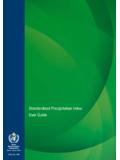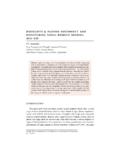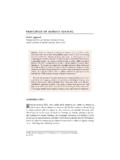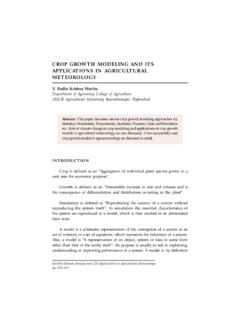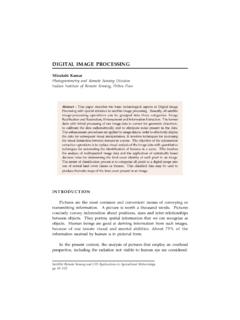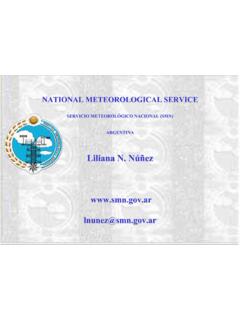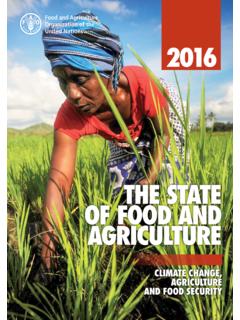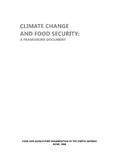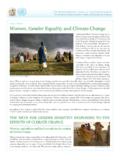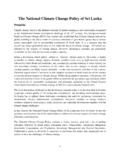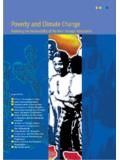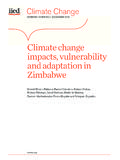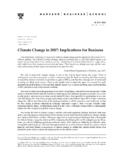Transcription of Climate Change Mitigation, Adaptation and …
1 1 Climate Change mitigation , Adaptation and sustainability in AgricultureMannava SivakumarRobert StefanskiWorld Meteorological Organization2 Presentation sustainability the concept and definitions Climate Change and sustainability the issues Climate Change impacts on agriculture Climate Change mitigation Climate Change Adaptation Climate Change Adaptation frameworks WMO Initiatives for Climate Change Adaptation Conclusions3 The emphasis on sustainability in several world forums makes one wonder whether it is a philosophy, a long term goal or a set of management practices. Rapidly rising population growth and diminishing arable land, particularly in the developing countries, has increased the stress on the natural resource base.
2 Growing concerns regarding the decline in the non-renewable sources of energy and the degradation of environment are leading us to take a hard look at the way natural resources have been exploited It is now incontestable that sustainable agriculture is seen as an important goal throughout the world. sustainability the Concept4 There is no generally accepted definition of sustainable agriculture . However, as Swindale (1988) explained, sustainability conveys the idea of a balance between human needs and environmental concerns. A common theme among definitions is that sustainable agricultural systems remain productive over time.
3 They should provide for the needs of current, as well as future generations, while conserving natural the Definition5 Rapidly raising greenhouse gases, enhanced land and sea temperatures and increased frequency and magnitude of extreme events pose enormous risks to various economic activities and fresh water availability and affect the sustainability of agriculture and food security of billions of people around the world, especially in the developing countries. Climate Change and sustainability the Issue6 Climate Change and sustainability Limits to expansion of landLimits to expansion of land Most good quality land is already being cultivated and no significant land expansion is expected in the future.
4 Agricultural sector will be under increasing pressures to ensure continued productivity, while safeguarding environmental quality. This depends on our ability to maintain the natural resource base that supports and sustains agriculture , especially in the developing world. 7 Climate is a renewable resource, but is variable in time and space. For proper and efficient use of the other two natural resources (soil and plant/animal genetic material), knowledge of the role of Climate is an essential precondition. Biological entities, such as crops, are not abstract entities, but a product of their temporal and genetic history in varying environments and there are lethal environmental thresholds which an organism can not transcend.
5 The relationships between the productive capacity of the resource base and the adsorptive capacity of the environment - the increasing problems of water and air pollution, soil erosion, and potential changes in the micro-and macro- Climate - are not well Change and sustainability Climatic thresholds8 As much as 80% of the variability in agricultural production is due to the variability in weather conditions In many developing countries where rainfed agriculture is the norm, a good rainy season means good crop production, enhanced food security and a healthy economy. Failure of rains and occurrence of natural disasters such as floods and droughts could lead to crop failures, food insecurity, famine, loss of property and life, mass migration, and negative national economic growth.
6 Climate Change and sustainability climatic risks9 Climate Change and sustainability Climate extremes Severe weather events that are responsible for natural disasters impact the socio-economic development of many nations Financial losses in 2005 are more than $200 billions with insurance claims running at more than $70 billions. In 2004, losses totalled about $145 billions and claims reached $45 rain in India's history centimeters ( inches) on 26 July 2005 in Mumbai was the highest rainfall in India s history Previous heaviest rainfall, was centimeters (33 inches) on July 12, 1910 recorded at Cherrapunji Floods caused a direct loss of about Rs 450 crores11 Climate Change and sustainability water for agriculture a crucial issue By 2025, population in water-scarce countries could rise to billion, representing roughly 30 per cent of the projected global population.
7 Over the next two decades, the world will need 17 per cent more water for agriculture and the total water use will increase by 40 per cent. In many developing countries, 70 per cent of the available fresh water is used for irrigation. 12 Climate Change and sustainability Climate Change and sustainability -- agriculture is also impacting climateAgriculture is also impacting Climate Area of cultivated land increased from about 265 Mha in 1700 to 1,473 Mha presently. Area under pasture increased from 524 to 3,215 Mha. 20% reduction in the global area of forests during the last 140 years releasing about 120 GT C to the Application of N fertilizers is possibly the largest human-induced source of N2O emissions in developed countries.
8 N2O has approximately 296 times the radiative forcing of CO2. Build-up of N2O and CH4in the atmosphere through enteric fermentation in ruminants, and manure management. Land degradation leads to higher surface reflectivity and less net radiation, atmosphere cooler, rain less frequent and vegetation growth reduced. Climate Change and sustainability Climate Change and sustainability -- agriculture is also impacting climateAgriculture is also impacting climate14 Climate Change and sustainability Climate Change and sustainability --Changes in land coverChanges in land cover Land use and vegetation type influence processes such as the transfer of heat and moisture from the land surface to the atmosphere.
9 These influence both weather and Climate through the impact on physical and biochemical properties. agriculture , through the discontinuities in vegetation and differences of soil moisture patterns, can influence the occurrence, location, and intensity of moist air convection. 15 Climate Change and sustainability Climate Change and sustainability --Changes in Changes in land coverland cover Between 1850 and 1990 approximately 123 Pg of carbon were released to the atmosphere as a result of changes in land use. This is equal to one-half the carbon released by fossil fuel combustion over the same period.
10 LUC currently contributes about 18% of the total annual CO2emissions; it accounts for about one-third of total emissions in developing countries, and 10% or less in developed countries. 16 Future Climate Change Warming in the 21st century greatest over land and at the highest northern latitudes. For the next two decades a warming of about C per decade is projected. Increases in the amount of precipitation are very likely in high latitudes, while decreases are likely inmost subtropical land regions. Drought-affected areas will likely increase in extent. It is very likely that hot extremes, heat waves and heavy precipitation events will continue to become more frequent.
